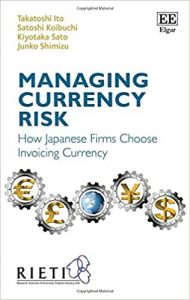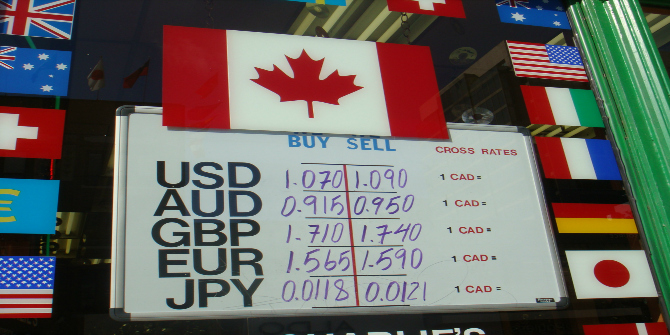In Managing Currency Risk: How Japanese Firms Choose Invoicing Currency, Takatoshi Ito, Satoshi Koibuchi, Kiyotaka Sato and Junko Shimizu explore the factors that influence why certain currencies are used in international trade by Japanese exporting firms. This well-written contribution offers a new approach to international currencies with conclusions that extend beyond the yen, writes Oscar Ugarteche, and will be useful for students of international finance, analysts who delve into international currencies and financial managers.
Managing Currency Risk: How Japanese Firms Choose Invoicing Currency. Takatoshi Ito, Satoshi Koibuchi, Kiyotaka Sato and Junko Shimizu. Edward Elgar. 2018.
 In Managing Currency Risk, Takatoshi Ito and a team of collaborative scholars, Satoshi Koibuchi, Kiyotaka Sato, Junko Shimizu and Edith Cowan, have returned with a brilliant new piece of research on how international currencies get defined and used. These scholars have delved into the issues surrounding international currencies since the creation of the Asian Currency Unit (Eiji Ogawa and Ito, 2000). The questions of how an international currency is defined and exists and how it can lose its status have been a matter of preoccupation for decades. From Robert Triffin’s Gold and the Dollar Crisis (1960) to the call for a change in the international reserve system by the People’s Bank of China Governor, Zhou Xiaochuan, in 2008 to more contemporary views on escalating the international ladder (see Luiz Fernando de Paula, Barbara Fritz and Daniela M. Prates, 2017), there remains the question of why the US dollar appears to be virtually the only international currency.
In Managing Currency Risk, Takatoshi Ito and a team of collaborative scholars, Satoshi Koibuchi, Kiyotaka Sato, Junko Shimizu and Edith Cowan, have returned with a brilliant new piece of research on how international currencies get defined and used. These scholars have delved into the issues surrounding international currencies since the creation of the Asian Currency Unit (Eiji Ogawa and Ito, 2000). The questions of how an international currency is defined and exists and how it can lose its status have been a matter of preoccupation for decades. From Robert Triffin’s Gold and the Dollar Crisis (1960) to the call for a change in the international reserve system by the People’s Bank of China Governor, Zhou Xiaochuan, in 2008 to more contemporary views on escalating the international ladder (see Luiz Fernando de Paula, Barbara Fritz and Daniela M. Prates, 2017), there remains the question of why the US dollar appears to be virtually the only international currency.
The issue of exchange rate risk has been central to the intellectual preoccupations of this book’s authors as the US dollar has grown increasingly unstable due to the monetary policies followed by the Federal Reserve Board (FED). The initial preoccupations of Ito et al with the unstable currency system were shown through their design of the Asian Currency Unit in 1997. They have worked on the subject for over twenty years and have finally produced this major work, which took over a decade. The results presented respond to three key questions that Ito et al address in the book, as outlined on page nine: firstly, if the currency risk is substantial, why don’t Japanese firms insist on denominating export prices in yen? Secondly, in the age of financial innovation, why don’t Japanese firms and importers use forward contracts with banks to hedge the currency risk? And thirdly, even if the importer currency is chosen as the invoice currency, why shouldn’t export prices be adjusted to reflect currency fluctuations?
The loss to Japanese firms through a tiny appreciation of the yen versus the US dollar is immense, according to interviews with the spokespersons of the corporations that make up the 225 Nikkei stock market index. The authors’ research therefore aims to identify the reasons why certain currencies are used and not others in international trade by Japanese firms, all of them multinationals that operate with value chains in Asia to export to the United States.

The authors define their three strands of empirical study on the choice of invoice currency. The first ‘entails conducting a cross country analysis of the invoice currency choice by collecting as much information as possible on the share of the invoice currency at the country level’ (19). The second is the use of unpublished data to discuss the exchange rate for invoice currency on a customs basis. The third is a questionnaire survey analysis of exporting firms and empirically tested determinants of invoice currency choice (20). The results are useful for forex discussions in international finance and international economics generally.
The authors point out that some recent studies have investigated the effect of invoice currency choice on exchange rate pass through (ERPT) and pricing to market (PTM). A very thorough analysis is made of the invoice currency choices in intra-firm trade using a 35-year invoice currency series from the interviewed corporations (1980-2015) to try and find trends from different angles. This provides an introductory analysis ahead of the interviews undertaken in Chapter Three, as to the whys and hows of currency invoicing decisions.
The authors initially held interviews on two occasions with 23 firms over a two-year period: the first in the fall of 2007 and the second in the fall of 2008. The sample firms were chosen from four different types of industry: automobile; electrical machinery; general machinery; and electrical components. These interviews are presented in Chapter Three with four key questions (66-68). The first concerns production and sales structure. The point here is to generate a profile of each company regarding (a) whether they had overseas production subsidiaries or not; (b) whether they had overseas sales subsidiaries and regional headquarters or if they trade through Japanese trading companies; (c) how they define the characteristics of goods traded, such as competitiveness and market share; and (d) finally identifying the basic corporate policy on exchange rate risk management.
The second question delves into invoice currency. Here, the main interest is in collecting data of invoicing currencies by destination at the firm level. The authors’ questions aimed at identifying which currency firms use in final sales from Japan to each destination country; in sales from Japan to overseas sales or production subsidiaries; and in sales from their overseas production subsidiaries to final destination markets. A final question is whether the invoicing choice is affected by inter- or intra-firm trade and/or the characteristics of the products traded, such as the degree of product differentiation.
Thirdly, the authors dig into exchange risk management and identify the different kinds of hedging strategies that firms use: forward, future and options through market, ‘marry and netting’, and so on. Finally, they inquire into price setting, seeking to determine whether interviewed firms periodically changed the export price itself irrespective of invoice currency choice. More precisely, they investigated whether they have any explicit policy regarding price revision in the face of sharp and substantial exchange rate fluctuations.
The evidence from the small sample of firms interviewed gave a blurred general picture. Chapter Four revises questionnaires made by the Research Institute of Economy, Trade and Industry (RIETI) on the firm-level invoicing currency choices of Japanese export firms. The initial survey questionnaire was sent in October-November 2009. It covered all listed firms in the Nikkei 225 in the manufacturing sector and had 227 responses, or 24.5% of the sample firms, 91.6% of which are manufacturing firms with more than 10 million US dollars in capital; 174 of the firms have over 300 employees. A second questionnaire survey was done by RIETI in September-October 2013 to 962 firms with 227 responses, a rate of 24%. All listed manufacturers’ foreign sales in their consolidated financial statements. For the second round of interviews, 185 firms were covered in total, all listed as exporting manufacturers (88). Only 69 replied to both surveys.
The results were that all firms from the second batch use the same currency both for invoice and settlings. The US dollar is used increasingly in Japanese exports to the world. The smaller the firm, the larger the invoicing in yen. The larger the firm size, the higher is the share of intra-firm trade. Invoicing in the importer’s currency is chosen for exports to the US, the Euro area and the UK. Asian currencies are not often chosen in Japanese exports to Asian countries.
Finally, the authors argue that the country in which the company happens to be established determines its fate when it comes to managing currency risk. American companies tend to benefit from the fact that the US dollar is the international currency. Japanese exporters face currency risk, because sometimes trading partners prefer invoicing and settlement in the US dollar (215). The central question of how we can determine how a currency is internationalised is answered finally in Chapter Seven. Using the three Keynesian components for the functions of a currency – a unit of account, a store of value and a medium of exchange – the authors proceed to conclude from their interviews as to what the private sector and the public sector do with each of these components.
In summary, the authors have found that in spite of the currency risk being substantial, Japanese firms invoice in US dollars because it is the choice of the importers. Secondly, Japanese firms and importers don’t hedge currency risk. Thirdly, in the cases where the importer currency is chosen as the invoice currency, prices are not adjusted to reflect currency fluctuations and are kept in dollars.
This book offers a new approach to a longstanding issue and sheds light on this field of study through the use of interviews to supplement economic and foreign exchange data. Well-written, concise and with a new approach to international currencies as well as conclusions that can be extended beyond the yen, this book will be useful for students of international finance, analysts who delve into international currencies, financial managers and renminbi trackers.
Note: This review gives the views of the author, and not the position of the LSE Review of Books blog, or of the London School of Economics.
Image Credit: .







